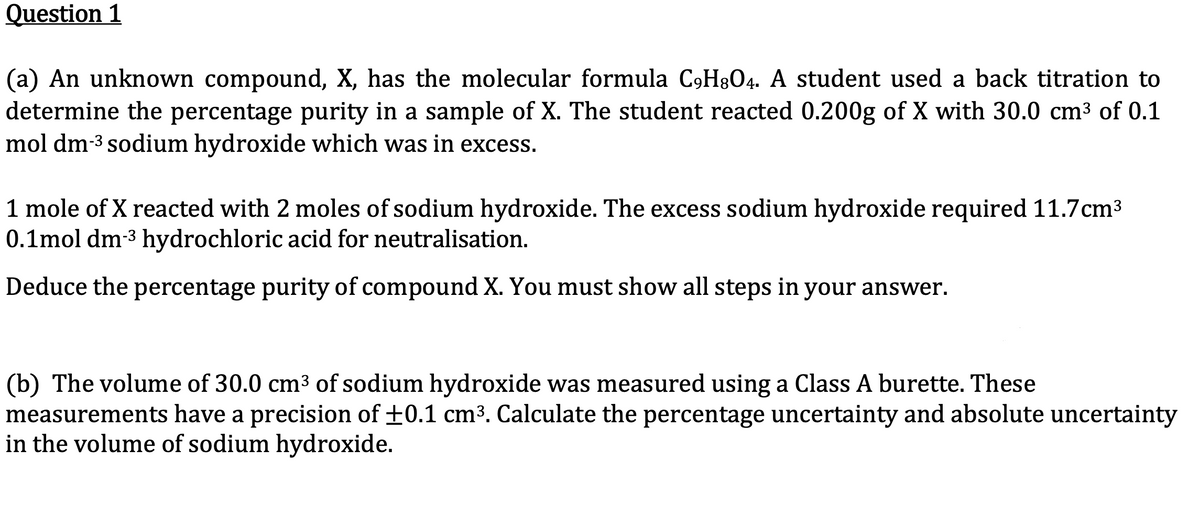Question 1 (a) An unknown compound, X, has the molecular formula C9H8O4. A student used a back titration to determine the percentage purity in a sample of X. The student reacted 0.200g of X with 30.0 cm³ of 0.1 mol dm-³ sodium hydroxide which was in excess. 1 mole of X reacted with 2 moles of sodium hydroxide. The excess sodium hydroxide required 11.7cm³ 0.1mol dm-³ hydrochloric acid for neutralisation. Deduce the percentage purity of compound X. You must show all steps in your answer. (b) The volume of 30.0 cm³ of sodium hydroxide was measured using a Class A burette. These measurements have a precision of ±0.1 cm³. Calculate the percentage uncertainty and absolute uncertainty in the volume of sodium hydroxide.
Question 1 (a) An unknown compound, X, has the molecular formula C9H8O4. A student used a back titration to determine the percentage purity in a sample of X. The student reacted 0.200g of X with 30.0 cm³ of 0.1 mol dm-³ sodium hydroxide which was in excess. 1 mole of X reacted with 2 moles of sodium hydroxide. The excess sodium hydroxide required 11.7cm³ 0.1mol dm-³ hydrochloric acid for neutralisation. Deduce the percentage purity of compound X. You must show all steps in your answer. (b) The volume of 30.0 cm³ of sodium hydroxide was measured using a Class A burette. These measurements have a precision of ±0.1 cm³. Calculate the percentage uncertainty and absolute uncertainty in the volume of sodium hydroxide.
Chemistry
10th Edition
ISBN:9781305957404
Author:Steven S. Zumdahl, Susan A. Zumdahl, Donald J. DeCoste
Publisher:Steven S. Zumdahl, Susan A. Zumdahl, Donald J. DeCoste
Chapter1: Chemical Foundations
Section: Chapter Questions
Problem 1RQ: Define and explain the differences between the following terms. a. law and theory b. theory and...
Related questions
Question

Transcribed Image Text:Question 1
(a) An unknown compound, X, has the molecular formula C9H8O4. A student used a back titration to
determine the percentage purity in a sample of X. The student reacted 0.200g of X with 30.0 cm³ of 0.1
mol dm-³ sodium hydroxide which was in excess.
1 mole of X reacted with 2 moles of sodium hydroxide. The excess sodium hydroxide required 11.7cm³
0.1mol dm-³ hydrochloric acid for neutralisation.
Deduce the percentage purity of compound X. You must show all steps in your answer.
(b) The volume of 30.0 cm³ of sodium hydroxide was measured using a Class A burette. These
measurements have a precision of ±0.1 cm³. Calculate the percentage uncertainty and absolute uncertainty
in the volume of sodium hydroxide.
Expert Solution
This question has been solved!
Explore an expertly crafted, step-by-step solution for a thorough understanding of key concepts.
Step by step
Solved in 4 steps

Knowledge Booster
Learn more about
Need a deep-dive on the concept behind this application? Look no further. Learn more about this topic, chemistry and related others by exploring similar questions and additional content below.Recommended textbooks for you

Chemistry
Chemistry
ISBN:
9781305957404
Author:
Steven S. Zumdahl, Susan A. Zumdahl, Donald J. DeCoste
Publisher:
Cengage Learning

Chemistry
Chemistry
ISBN:
9781259911156
Author:
Raymond Chang Dr., Jason Overby Professor
Publisher:
McGraw-Hill Education

Principles of Instrumental Analysis
Chemistry
ISBN:
9781305577213
Author:
Douglas A. Skoog, F. James Holler, Stanley R. Crouch
Publisher:
Cengage Learning

Chemistry
Chemistry
ISBN:
9781305957404
Author:
Steven S. Zumdahl, Susan A. Zumdahl, Donald J. DeCoste
Publisher:
Cengage Learning

Chemistry
Chemistry
ISBN:
9781259911156
Author:
Raymond Chang Dr., Jason Overby Professor
Publisher:
McGraw-Hill Education

Principles of Instrumental Analysis
Chemistry
ISBN:
9781305577213
Author:
Douglas A. Skoog, F. James Holler, Stanley R. Crouch
Publisher:
Cengage Learning

Organic Chemistry
Chemistry
ISBN:
9780078021558
Author:
Janice Gorzynski Smith Dr.
Publisher:
McGraw-Hill Education

Chemistry: Principles and Reactions
Chemistry
ISBN:
9781305079373
Author:
William L. Masterton, Cecile N. Hurley
Publisher:
Cengage Learning

Elementary Principles of Chemical Processes, Bind…
Chemistry
ISBN:
9781118431221
Author:
Richard M. Felder, Ronald W. Rousseau, Lisa G. Bullard
Publisher:
WILEY